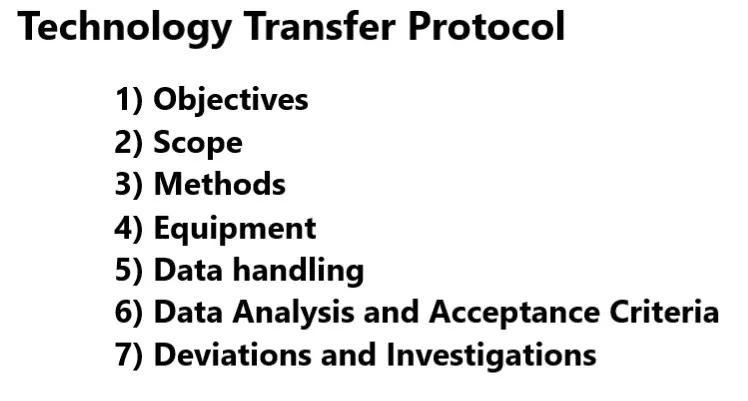Learn about the key sections and importance of a technology transfer protocol for smooth knowledge transfer between labs.

Technology Transfer Protocol
Technology transfer protocol is a document create to transfer a technology from one lab to another. Sometimes, if a contract manufacturer or laboratory is involved, they may have their own procedures that need to be followed. It outlines the objectives, scope, materials, methods, equipment, experimental design, data handling, acceptance criteria, and how to handle any deviations or issues.
When transferring a method from an API supplier, the manufacturing site may create a protocol that includes repeating the method validation or testing multiple batches. They compare the results with the supplier’s Certificates of Analysis (COAs).
key aspects of protocol
- Objective: This section states the project and identifies the labs involved in the technology transfer.
- Scope: The methods will define here, as well as any methods that do not require transfer.
- Materials, Methods and Equipment: This section lists the specific batch numbers, reference standard lot numbers and method references. It also mentions sample age and uniformity. Equipment using in the transfer should define.
- Experimental Design: This section explains the step-by-step procedure during the transfer. It includes number of batches, analysts, replicates, instruments and any additional important information not mentioned in the procedure itself. This could involve sample and standard preparation, the number of injections, the order of injections, dissolution process and the time.
- Data and Data Report Forms: The protocol should specify which lab will document the raw data and how to share final. The originating lab typically receives the results on a data report form, which is added to the transfer protocol. Alternatively, they may receive the results through a Laboratory Information Management System (LIMS).
- Data Analysis and Acceptance Criteria: This section states who will perform the data analysis and outlines the acceptance criteria. The acceptance criteria may vary between labs or statistical analysis.
- Deviations and Investigations: This section explains handling issues by following the lab standard operating procedures (SOP). Examples of deviations could include incorrect mobile phase used, weighing errors, equipment malfunctions or broken glassware. If any problems arise, the transfer team will work together to find a solution that ensures the successful transfer of the technology.
Also read SUPAC guidelines. WHO guidelines in technology transfer.
